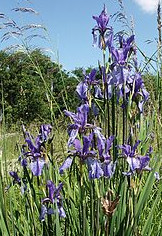ELEMENT COMPOSITION IRIS SIBIRICA L. IN CULTURE IN VITRO
Abstract
The development of biotechnological methods for producing medicinal plants, preserving valuable elemental and chemical composition of the group, is one of the most important tasks of the pharmaceutical and food industries.
The purpose of this work – the study of the elemental composition of regenerated plants I. sibirica compared with intact plants.
We studied the biomass of leaves and rhizomes and roots of plants regenerated I. sibirica variety and grade of Cambridge Sterh multiplied microclonal in VPO "Altai State University" (Barnaul, Russia). The elemental composition was evaluated according to the atomic emission spectrometry (ICP-spectrometer Optima 7300 DV firm Perkin Elmer).
The evaluation of the intensity and specificity of accumulation of chemical elements regenerated plant bodies I. sibirica of culture media in tissue culture. On the basis of the data obtained revealed the elements of energetic savings – K, Mg, Fe, Mn, Zn, Mo Cu, as well as a strong element of accumulation – Co. Calcium in the regenerated plant leaves is defined as an element of energetic savings, and in the roots and rhizomes as an element of a strong accumulation. Two varieties of I. sibirica Cambridge Sterh and accumulate in the tissue culture of the chemical elements with the same intensity.
On the basis of spectrometric analysis in biomass I. sibirica identified 24 chemical elements, made a series of preferential accumulation: K > Ca > Mg > Fe > Al > Na > Mn > Zn > Sr > Ba > Ti > Cu > V > Pb > Ni > As > Mo > Co > Sb > Sn > Se > Cd > Ag > Be. Studies have shown that the qualitative composition of the elements found in plants regenerated I. sibirica and intact plants, identical, while the quantitative content differed significantly. Established regenerated plants I. sibirica variety Cambridge are the hub of manganese (leaves, roots and rhizomes). In the studied samples I. sibirica variety Cambridge, the concentration of heavy metals Pb, Cd and As do not exceed the permissible level for dietary supplements of plant-based.
The possibility of using plants regenerated and intact plants I. sibirica as sources of various macro- and microelements. It should also be tailored to specific storage elements investigated during cultivation I. sibirica in vitro.
Downloads
Metrics
References
Alekseenko V.A. Sorosovskii obrazova-tel'nyi zhurnal, 2001, vol. 7, no. 8, pp. 20–24. (in Russ.).
Alekseeva N.B. Vidy roda Iris vo flore Rossii. Problemy okhrany v prirode i introduktsii: Avtoref. dis. …kand. biol. nauk. [Species of the genus Iris in the flora of Russia. Problems of protection in nature and introductions: Author's abstract. Dis. Candidate of Biological Sciences]. St. Petersburg, 2005, 23 p. (in Russ.).
Tikhomirova L.I., Bazarnova N.G., Mikushina I.V., Dolganova Z.V. Khimiia rastitel'nogo syr'ia, 2015, no. 3, pp. 25–34. (in Russ.).
Bazarnova N.G., Il'icheva T.N., Tikhomirova L.I., Sinitsyna A.A. Khimiia rastitel'nogo syr'ia, 2016, no. 3, pp. 49–57. (in Russ.).
Dorofeev V.Iu., Karnachuk R.A., Shilova I.V. Vestnik Tomskogo gosudarstvennogo universiteta. Biologiia, 2008, no. 2, pp. 12–17. (in Russ.).
Aslaniants L.K., Marshavina Z.V. Prikladnaia biokhimiia i mikrobiologiia, 1979, vol. 15, pp. 769–774. (in Russ.).
Aslaniants L.K., Marshavina Z.V., Kazarian A.G. Rastitel'nye resursy, 1988, vol. 24, pp. 107–110. (in Russ.).
Bagdasarova Z.M., Aslaniants L.K., Uzunian L.V. Prikladnaia biokhimiia i mikrobiologiia, 1988, vol. 24, pp. 774–778. (in Russ.).
Tikhomirova L.I. Biotechnology in Russia, 2013, no. 2, pp. 74–78.
Perel'man A.I. Geokhimiia. [Geochemistry]. Moscow, 1989, 528 p. (in Russ.).
Afanas'eva L.V. Khimiia rastitel'nogo syr'ia, 2016, no. 3, pp. 103–108. (in Russ.).
Fiziologiia rastenii: Uchebnik dlia studentov vuzov. [Plant Physiology: A Textbook for University Students], ed. Ermakov I.P., Moscow, 2005, 640 p. (in Russ.).
Kopylova L.V. Izvestiia Samarskogo nauchnogo tsentra RAN, 2010, vol. 12, no. 1(3), pp. 709–712. (in Russ.).
Levanidov L.Ia., Davydov S.T. Marganets kak mikroelement v sviazi s biokhimiei i svoistvami tannidov. [Manganese as a trace element in connection with biochemistry and properties of tannins]. Cheliabinsk, 1961, 187 p. (in Russ.).
Spravochnik vracha. Mineral'nye veshchestva lekarstvennykh rastenii. [Directory of the doctor. Mineral substances of medicinal plants]. [Elektronnyi resurs]. URL: http://spravr.ru/mineralnye-veshchestva-lekarstvennyh-rasteniy.html. (in Russ.).
El'chininova O.A., Rozhdestvenskaia T.A., Chernykh E.Iu. Bioraznoobrazie, problemy ekologii Gornogo Altaia i sopredel'nykh regionov: nastoiashchee, proshloe, budushchee. Materialy Mezhdunarodnoi konferentsii. [Biodiversity, ecological problems of the Mountainous Altai and adjacent regions: the present, the past, the future. Materials of the International Conference]. 2008, pp. 51–55. (in Russ.).
Il'in V.B. Tiazhelye metally v sisteme pochva – rastenie. [Heavy metals in the soil-plant system]. Novosibirsk, 1991, 151 p. (in Russ.).
SanPiN 2.3.2.1078-01. Gigienicheskie trebovaniia bezopasnosti i pishchevoi tsennosti pishchevykh produktov. [SanPiN 2.3.2.1078-01. Hygienic requirements for food safety and nutritional value]. Moscow, 2001, pp. 187–188. (in Russ.).


This work is licensed under a Creative Commons Attribution 4.0 International License.
The authors, which are published in this journal, agree to the following conditions:
1. Authors retain the copyright to the work and transfer to the journal the right of the first publication along with the work, at the same time licensing it under the terms of the Creative Commons Attribution License, which allows others to distribute this work with the obligatory indication of the authorship of this work and a link to the original publication in this journal .
2. The authors retain the right to enter into separate, additional contractual agreements for the non-exclusive distribution of the version of the work published by this journal (for example, to place it in the university depository or to publish it in a book), with reference to the original publication in this journal.
3. Authors are allowed to post their work on the Internet (for example, in a university repository or on their personal website) before and during the review process of this journal, as this may lead to a productive discussion, as well as more links to this published work.











